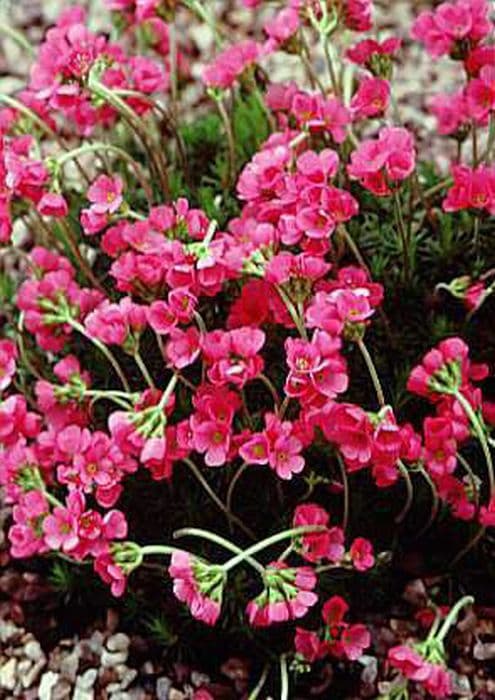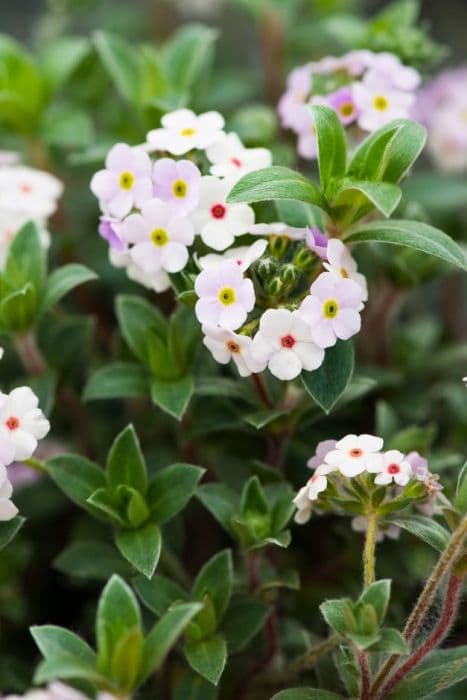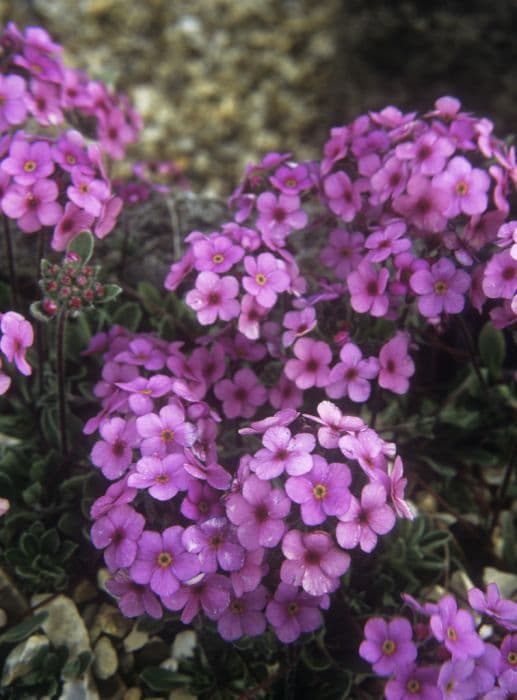Pink Ice Primrose Primula Belarina Pink Ice = 'Kerbelpice' (PBR) (Belarina Series) (Pr/prim/d)
![primrose [Belarina Pink Ice]](/_next/image?url=https%3A%2F%2Fplants-admin.emdemapps.com%2Fimages%2Fplants%2F%2Fimages%2F604b61ffc8d33.png&w=3840&q=75)
ABOUT
Primula Belarina Pink Ice is a charming perennial plant that features a rosette of rich green leaves, which creates a lush, verdant backdrop for its floral display. The leaves are typically crinkled with a somewhat ruffled texture, providing a touch of visual interest even when the plant is not in bloom. The true allure of this Primula lies in its blossoms; the Pink Ice variety is adorned with clusters of double, rose-like flowers. These intricate blooms present layers of pink petals, often showcasing various shades, from soft pastels to deeper blushes, all blending harmoniously together. The flowers have a frilly, ruffled appearance, each petal delicately edged, contributing to the overall ornate and romantic feel of the plant. The blooms can sometimes give off a light, pleasing fragrance that can be a delightful addition to any garden space. The appearance of Primula Belarina Pink Ice is reminiscent of a classic cottage garden, with its lush foliage and elegant, multi-petaled flowers providing a dash of old-fashioned charm and grace to its surroundings.
About this plant
 Names
NamesFamily
Primulaceae
Synonyms
Belarina Pink Ice Primrose, Double Pink Ice Primrose
Common names
Primula Belarina Pink Ice = 'Kerbelpice' (PBR) (Belarina Series) (Pr/prim/d).
 Toxicity
ToxicityTo humans
The Primula, commonly referred to as primrose, is not generally considered toxic to humans. However, some individuals may experience an allergic reaction when coming into contact with the plant, particularly if they have sensitive skin. This can include contact dermatitis, which is characterized by red, itchy, and inflamed skin. Ingesting parts of the plant is not advisable as it may cause mild stomach upset in some individuals, but the toxicity level is typically low.
To pets
Primula, or primrose, is generally considered to have a low level of toxicity to pets. If a pet ingests a large amount of the plant, it might experience mild gastrointestinal upset, such as vomiting or diarrhea. The irritation, mainly due to the saponins present in the plant, is usually not severe. Signs of primrose poisoning in pets are generally not systemic and are limited to gastrointestinal discomfort.
 Characteristics
CharacteristicsLife cycle
Perennials
Foliage type
Evergreen
Color of leaves
Green
Flower color
Pink
Height
6 inches (15 cm)
Spread
8 inches (20 cm)
Plant type
Herb
Hardiness zones
5
Native area
Europe
Benefits
 General Benefits
General Benefits- Long Blooming Period: It often has a prolonged flowering period spanning from late winter to late spring.
- Compact Growth Habit: Ideal for small gardens, containers, and border fronts due to its compact size.
- Colorful Addition: The pink “Ice” flowers offer a splash of color when few other plants are in bloom.
- Low Maintenance: Requires minimal care once established, making it suitable for busy gardeners.
- Cold Tolerant: Hardy in various climates and can withstand cold temperatures, making it a versatile choice for many regions.
- Attracts Pollinators: The vibrant flowers attract bees and butterflies, supporting local ecosystems.
- Deer and Rabbit Resistant: Its foliage and flowers are generally not favored by deer or rabbits.
 Medical Properties
Medical PropertiesThis plant is not used for medical purposes.
 Air-purifying Qualities
Air-purifying QualitiesThis plant is not specifically known for air purifying qualities.
 Other Uses
Other Uses- Edible Decoration: The flowers of the Primula Belarina Pink Ice can be crystallized with egg whites and sugar to create beautiful and edible decorations for desserts.
- Photography Subject: Due to its unique and striking appearance, this Primula can serve as an excellent subject for botanical photographers and artists.
- Craft Inspiration: The vibrant petals can inspire the color schemes and designs for crafts such as pressed flower art or nature-themed jewelry.
- Garden Teaching Tool: This plant can be used in educational gardens to teach about perennial life cycles and spring bloomers in temperate climates.
- Fragrance Extraction: The subtle fragrance of Primula Belarina Pink Ice flowers could be used in the production of natural perfumes and scented candles.
- Special Events: They can be used in table settings or as part of floral arrangements for springtime events such as weddings and Easter celebrations.
- Thematic Gardening: It can be incorporated into fairy or miniature gardens for a touch of whimsy and color contrast.
- Color Therapy: The calming pink hues can be used in color therapy gardens designed to create a peaceful, restorative environment.
- Art Dye: The pigments from the petals might be extracted to create natural dyes for fabrics, papers, or inks used in artworks.
- Environmental Indicator: As an early spring bloomer, the plant can be observed for changes in blooming patterns as an indicator of climate change effects.
Interesting Facts
 Feng Shui
Feng ShuiThe Primula is not used in Feng Shui practice.
 Zodiac Sign Compitability
Zodiac Sign CompitabilityThe Primula is not used in astrology practice.
 Plant Symbolism
Plant Symbolism- Youthfulness: The Primula, with its early bloom, is often considered a symbol of youth and renewal, representing the fresh start of spring.
- Innocence: The delicate appearance of the Primula evokes feelings of purity and innocence.
- Hope: As one of the first flowers to bloom in spring, the Primula signifies hope and the anticipation of things to come.
- New Beginnings: The Primula's emergence after winter months symbolizes new beginnings and the cycle of life.
- Love and Romance: In the context of its soft pink color, the Primula Belarina Pink Ice may carry connotations of gentle love, tenderness, and romance.
 Water
WaterPink Ice Primrose needs consistent moisture, so water it when the top inch of soil feels dry to the touch. Typically, they require watering once or twice a week, depending on the surrounding temperature and humidity levels. Provide enough water to saturate the soil without flooding the plant, which translates to approximately 1 gallon per week for outdoor varieties. It's crucial not to let them dry out completely, but be careful not to overwater to prevent root rot.
 Light
LightPink Ice Primrose thrives in partial shade conditions with filtered sunlight. The ideal location is where the plant receives morning light but is protected from the intense sun in the afternoon. An east or north-facing window or a spot that provides dappled sunlight throughout the day would be perfect.
 Temperature
TemperatureThe Pink Ice Primrose prefers cool temperatures, thriving best in a range where the daytime temperature is between 60 to 75 degrees Fahrenheit and nighttime temperatures are above freezing, ideally not dropping below 40 degrees Fahrenheit. They can survive temporary dips below this range, but prolonged exposure to temperatures above 80 degrees Fahrenheit or below freezing may harm the plant.
 Pruning
PruningPruning Pink Ice Primrose is necessary to remove spent flowers and encourage continuous blooming throughout the season. Deadheading, or cutting off the faded blooms, should be done regularly, as flowers fade. Pruning can also help maintain a compact form and promote overall plant health. The best time for more extensive pruning is immediately after the blooming cycle has finished.
 Cleaning
CleaningAs needed
 Soil
SoilThe Double Primrose requires well-draining soil enriched with organic matter. A mix consisting of equal parts peat, garden loam, and perlite or sand works well to foster healthy growth. It thrives best at a slightly acidic to neutral soil pH of 6.0 to 7.0.
 Repotting
RepottingDouble Primroses like 'Belarina Pink Ice' should be repotted annually. It's best to repot them in the spring, after flowering, to refresh the soil and accommodate root growth.
 Humidity & Misting
Humidity & MistingDouble Primroses prefer high humidity levels, ideally between 50-60%. They thrive in environments that mimic their native habitat, which is cool and moist.
 Suitable locations
Suitable locationsIndoor
Place in bright, indirect light with moist soil.
Outdoor
Plant in partial shade, ensure moist, well-draining soil.
Hardiness zone
4-8 USDA
 Life cycle
Life cycleThe Primula Belarina Pink Ice, commonly known as Pink Ice Primrose, begins its life cycle as a seed, which upon germination under suitable conditions of moisture and temperature, develops a small rosette of leaves close to the ground. As the plant matures, it develops a more robust root system and larger, more defined foliage, leading to its vegetative growth stage. In late winter to early spring, the Primrose enters its flowering stage, producing clusters of pink double-flowers that add ornamental value. After pollination—often facilitated by insects—the flowers develop into seed capsules, completing the reproductive stage. Once the seeds mature, they are dispersed by wind, water, or animal vectors to begin a new life cycle. As a perennial, the Pink Ice Primrose will enter a period of dormancy in its lifecycle, typically during the colder months, where above-ground growth dies back, and the plant conserves energy through its root system until favorable conditions return for the next growing season.
 Propogation
PropogationPropogation time
Early spring
Primula Belarina Pink Ice is commonly propagated through division, which is typically the most popular method for this cultivar. This process is best performed in late summer or early fall, post-flowering, to allow the plant time to establish before winter. To propagate through division, carefully dig up the plant, ensuring a sizeable root ball is intact. Use a sharp, clean knife or spade to divide the clump into smaller sections, each with several shoots and an adequate amount of roots. Replant the divisions at the same depth they were growing previously, spacing them about 6 to 8 inches (15 to 20 centimeters) apart to provide them with ample room to grow. Water the new plantings thoroughly to help establish them in their new locations.









